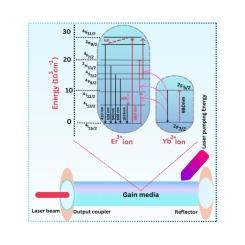Yb3+离子浓度对Er3+掺杂铌基磷酸盐玻璃结构和近红外发光的影响
IF 3.4
3区 物理与天体物理
Q2 INSTRUMENTS & INSTRUMENTATION
引用次数: 0
摘要
本文研究了Yb3+离子浓度对Er3+掺杂铌酸盐基磷酸盐玻璃的物理和发光性能的影响。采用熔融淬火技术合成了化学成分为P2O5: Nb2O5: Na2O: Li2O: Er2O3: Yb2O3的新型玻璃体系。随着Yb2O3浓度的增加,样品的密度呈增大趋势,而摩尔体积呈减小趋势。利用Judd-Ofelt (JO)理论计算了JO强度参数,从而得到了Er3+离子的辐射寿命、荧光分支比和辐射跃迁概率。这些参数的变化趋势为Ω2 >; Ω4 >; Ω6。此外,Yb2O3掺杂后,光学带隙(Eopt)减小,这是由于在玻璃网络中形成了非桥氧(NBOs)。nbo的增加减少了价带最大值和导带最小值之间的分离,从而为能量转移过程提供了更有利的环境。此外,由于Yb3+和Er3+离子之间的能量转移,近红外发光带(4I13/2→4I15/2)对应的1530 nm峰强度随Yb2O3浓度的变化而变化。Er3+: Yb3+的最佳摩尔比为1:7 . 0,显示出这些玻璃的最高发光比。这种发光的增强归因于Yb3+和Er3+离子之间有效的能量转移机制,使这些玻璃非常适合应用于光放大器和激光器等光子器件。本研究的发现为激光和其他先进光学应用的稀土掺杂磷酸盐玻璃的设计和优化提供了有价值的见解。本文章由计算机程序翻译,如有差异,请以英文原文为准。

The impact of Yb3+ ions concentration on the structure and NIR luminescence of Er3+ doped niobium based phosphate glasses
This study investigates the influence of Yb3+ ion concentration on the physical and luminescence properties of Er3+-doped niobate-based phosphate glasses. A system of novel glasses with chemical composition of P2O5: Nb2O5: Na2O: Li2O: Er2O3: Yb2O3 were synthesized through melt quenching technique. The density of the samples shows an increasing trend while the molar volume demonstration a decreasing trend with increasing Yb2O3 concentration. The Judd-Ofelt (JO) theory was utilized to compute the JO intensity parameters, which subsequently yielded the radiative lifetimes of Er3+ ions, fluorescence branching ratios, and radiative transitions probability. These parameters exhibit a trend of Ω2 > Ω4 > Ω6. Furthermore, the optical band gap (Eopt) was found to decrease with Yb2O3 doping, which was attributed to the formation of non-bridging oxygen (NBOs) in the glass network. The increase in NBOs reduced the separation between the valence-band maxima and conduction-band minima, leading to a more favorable environment for energy transfer processes. Additionally, owing to the energy-transfer among Yb3+ and Er3+ ions, the intensity of peak at 1530 nm corresponding to the near-IR luminescence band (4I13/2 → 4I15/2) changes with Yb2O3 concentration. The optimum molar ratio Er3+: Yb3+ i.e. 1:0.7, show the highest luminescent ratio for these glasses. This enhancement in luminescence is attributed to the effective energy transfer mechanism between Yb3+ and Er3+ ions, making these glasses highly suitable for applications in photonic devices, such as optical amplifiers and lasers. The findings of this study provide valuable insights into the design and optimization of rare-earth-doped phosphate glasses for laser and other advanced optical applications.
求助全文
通过发布文献求助,成功后即可免费获取论文全文。
去求助
来源期刊
CiteScore
5.70
自引率
12.10%
发文量
400
审稿时长
67 days
期刊介绍:
The Journal covers the entire field of infrared physics and technology: theory, experiment, application, devices and instrumentation. Infrared'' is defined as covering the near, mid and far infrared (terahertz) regions from 0.75um (750nm) to 1mm (300GHz.) Submissions in the 300GHz to 100GHz region may be accepted at the editors discretion if their content is relevant to shorter wavelengths. Submissions must be primarily concerned with and directly relevant to this spectral region.
Its core topics can be summarized as the generation, propagation and detection, of infrared radiation; the associated optics, materials and devices; and its use in all fields of science, industry, engineering and medicine.
Infrared techniques occur in many different fields, notably spectroscopy and interferometry; material characterization and processing; atmospheric physics, astronomy and space research. Scientific aspects include lasers, quantum optics, quantum electronics, image processing and semiconductor physics. Some important applications are medical diagnostics and treatment, industrial inspection and environmental monitoring.

 求助内容:
求助内容: 应助结果提醒方式:
应助结果提醒方式:


